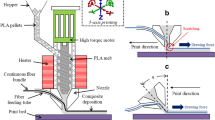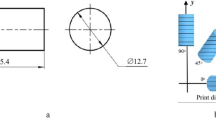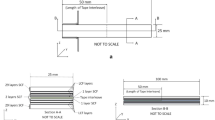Abstract
This paper evaluated corn starch/cellulose acetate (SCA) specimens 3D-printed by the fused deposition modeling (FDM) method. The influence of the printing parameters, nozzle temperature, and flow rate on the morphological and mechanical properties of the specimens was evaluated. Scanning electron microscopy (SEM) showed smooth surfaces on all the 3D-printed specimens. The fracture surface analysis revealed homogeneity and low porosity of the specimens printed at 230 °C and 90% flow rate. The flexural tests showed high values of the flexural modulus for the specimens printed at 240 °C and 80% flow rate, and the fatigue tests demonstrated that the 230-90 SCA specimens were resistant to successive cyclic loads.
Similar content being viewed by others
References
Alhnan MA, Okwuosa TC, Sadia M, Ka-WaiWan, Ahmed W, Arafat B (2016) Emergence of 3D printed dosage forms: opportunities and challenges. Pharm Res 33:1817–1832
Avanzini A, Donzella G, Gallina D, Pandini S, Petrogalli C (2013) Fatigue behavior and cyclic damage of peek short fiber reinforced composites. Compos Part B 45:397–406
Bose S, Ke D, Sahasrabudhe H, Bandyopadhyay A (2018) Additive manufacturing of biomaterials. Prog Mater Sci 93:45–111
Bumgarner B (2013) Getting started with a 3D printer. Make. Pages 12–16
Bastioli C (1998) Properties and applications of Mater-Bi® starch-based materials. Polym Degrad Stab 59:263–271
Corradini E, Teixeira EM, Agnelli JAM, Matoso LHC Aimdo Termoplástico. São Carlos: Embrapa Instrumentação Agropecuária, 2007
Goyanes A, Fina F, Martorana A, Sedough D, Gaisford S, Basit AW (2017) Development of modified release 3D printed tablets (printlets) with pharmaceutical excipients using additive manufacturing. Int J Pharm 527(1–2):21–30
Goole J, Amighi K (2016) 3D printing in pharmaceutics: A new tool for designing customized drug delivery systems. Int J Pharm 499(1–2):376–394
Zepon KM, Vieira LF, Soldi V, Salmoria GV, Kanis LA (2013) Influence of process parameters on microstructure and mechanical properties of starch-cellulose acetate/silver sulfadiazine matrices prepared by melt extrusion. Polym Test 32(6):1123–1127
Khaled SA, Burley JC, Alexander MR, Roberts CJ (2014) Desktop 3D printing of controlled release pharmaceutical bilayer tablets. Int J Pharm 461(1–2):105–111
Khaled SA, Burley JC, Alexander MR, Yang J, Roberts CJ (2015) 3D printing of tablets containing multiple drugs with defined release profiles. Int J Pharm 494(2):643–650
Lee JY, An J, Chua CK (2017) Fundamentals and applications of 3D printing for novel materials. Appl Mater Today 7:120–133
Leon AC, Chen Q, Palaganas NB, Palaganas JO, Manapat J, Advincula RC (2016) High performance polymer nanocomposites for additive manufacturing applications. React Funct Polym 103:141–155
Maroni A, Melocchi A, Parietti F, Foppoli A, Zema L, Gazzaniga A (2017) 3D printed multi-compartment capsular devices for two-pulse oral drug delivery. J Control Release 268:10–18
Melocchi A, Parietti F, Maroni A, Foppoli A, Gazzaniga A, Zema L (2016) Hot-melt extruded filaments based on pharmaceutical grade polymers for 3D printing by fused deposition modeling. Int J Pharm 509(1–2):255–263
Park JS, Kim T, Kim WS (2017) Conductive cellulose composites with low percolation threshold for 3D printed electronics. Sci Rep 7(3246)
Pattinson SW, Hart AJ (2017) Additive manufacturing of cellulosic materials with robust mechanics and antimicrobial functionality. Adv Mater Technol 1-6
Pereira AS, Cunha AM, Reis RL (1998) Newstarch-based thermoplastic hydrogels for use as bone cements or drug-delivery carriers. J Mater Sci Med 9:825–833
Salmoria GV, Klauss P, Paggi RA, Kanis LAAL (2009) Structure and mechanical properties of cellulose based scaffolds fabricated by selective laser sintering. Polym Test 28(6):648–652
Solanki NG, Tahsin M, Shah AV, Serajuddin ATM (2018) Formulation of 3D printed tablet for rapid drug release by fused deposition modeling: screening polymers for drug release. Drug-polymer miscibility and printability. J Pharm Sci 107(1):390–401
Yang Y, Wang H, Li H, Ou Z, Yang G (2018) 3D printed tablets with internal scaffold structure using ethyl cellulose to achieve sustained ibuprofen release. Eur J Pharm Sci 115:11–18
Yao Z, Wu D, Chen C, Zhang M (2013) Creep behavior of polyurethane nanocomposites with carbon nanotubes. Compos Part A 50:65–72
Zepon KM, Petronilho F, Soldi V, Salmoria GV, Kanis LA (2014) Production and characterization of cornstarch/cellulose acetate/silver sulfadiazine extrudate matrices. Mater Sci Eng C 44:225–233
Zhang J, Feng X, Patil H, Tiwari RV, Repka MA (2017) Coupling 3D printing with hot-melt extrusion to produce controlled-release tablets. Int J Pharm 519(1–2):186–197
Pietrzak K, Isreb A, AA Mohamed (2015) European journal of pharmaceutics and biopharmaceutics 96:380–387. https://doi.org/10.1016/j.ejpb.2015.07.027
Acknowledgements
The authors would like to thank PRONEX-FAPESC, CAPES, and CNPq for the financial support and CERMAT for the electronic micrographics.
Author information
Authors and Affiliations
Corresponding author
Rights and permissions
About this article
Cite this article
Paggi, R.A., Salmoria, G.V., Ghizoni, G.B. et al. Structure and mechanical properties of 3D-printed cellulose tablets by fused deposition modeling. Int J Adv Manuf Technol 100, 2767–2774 (2019). https://doi.org/10.1007/s00170-018-2830-z
Received:
Accepted:
Published:
Issue Date:
DOI: https://doi.org/10.1007/s00170-018-2830-z




